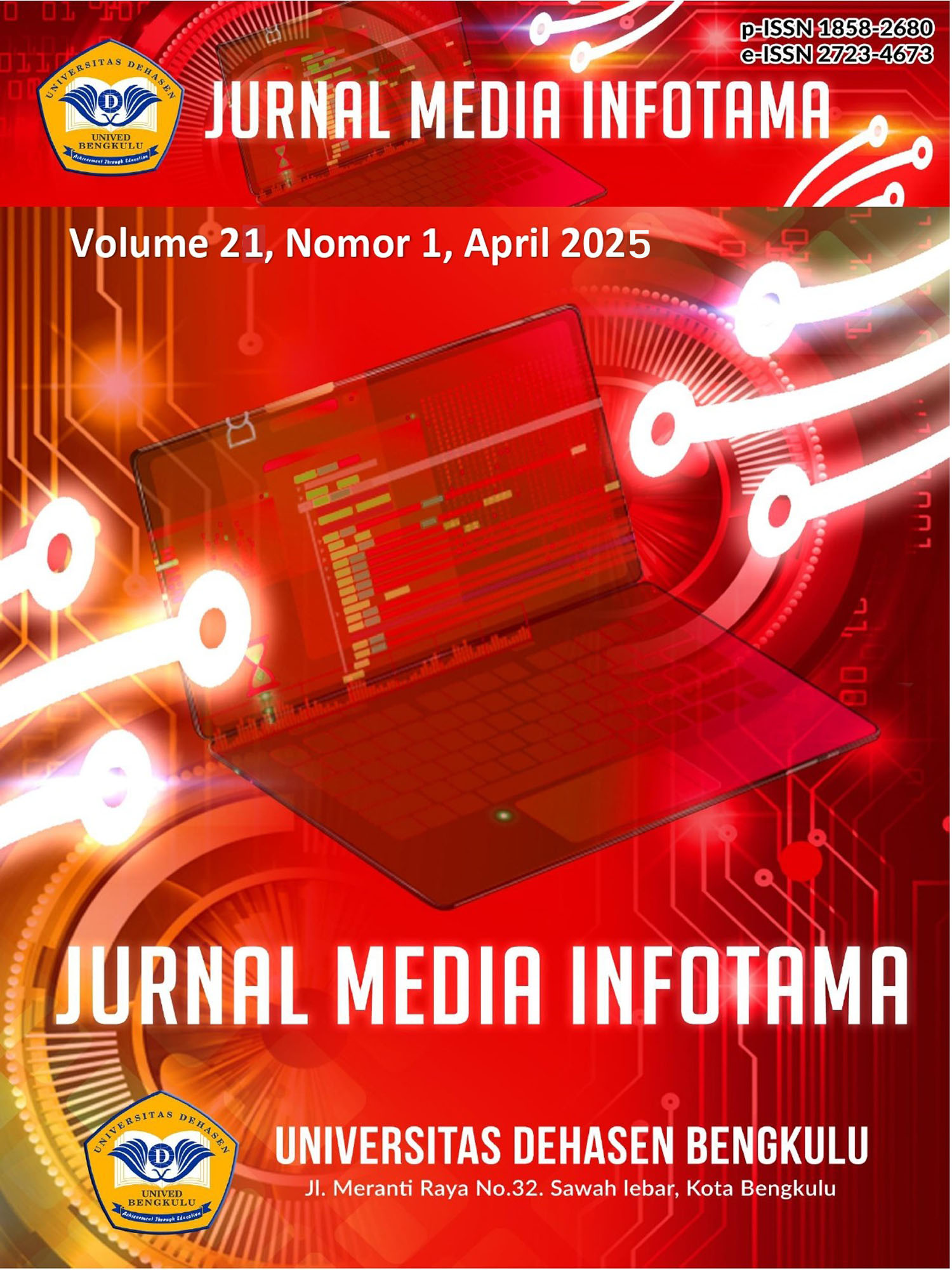Sistem Otomatis Exhaust Berdasarkan Kapasitas Asap Dalam Ruangan Berbasis Internet of Things (IoT)
Abstract
Adeeva Hotel Bengkulu City is one of the hotels in Bengkulu City that provides room rental services, such as rooms for meetings, seminars and parties. Currently, Adeeva Hotel has 4 meeting rooms, two of which are smoking rooms. Currently, there is no system in the room that can detect smoke conditions in the room.In this study using library methods, observation, interviews and laboratories, designing a system that can detect smoke levels in a room, where the sensor will read or detect smoke levels in the room, the sensor used in detecting smoke is the MQ2 sensor. While for data processing using ESP8266 with a program on the tool made using Arduino ide and for the Internet of Things (IoT) using Blynk.The system can detect smoke levels in the room, which is carried out by the MQ2 sensor, the detection results will be processed by ESP8266 where if the smoke levels in the room are large (>) from 10 PPM, ESP8266 will send a command to the relay to turn on the exhaust, so that the smoke in the room will be released out. Besides being based on exhaust sensor detection, it can be turned on and off manually via the application by entering manual mode.
Downloads
References
[2] Abdurahman, Hasan. 2021. Aplikasi Pinjaman Pembayaran Secara Kredit Pada Bank Yudha Bhakti. Jurnal Computech & Bisnis. STMIK Mardira Indonesia, Bandung
[3] Awal, Hasri. 2019. Perancangan Prototype Smart Home Dengan Konsep Internet Of Thing (IoT) Berbasis Web Server. Majalah Ilmiah UPI YPTK. Universitas Putra Indonesia “YPTK” Padang
[4] Haryanto, Dadang. 2019. Tempat Sampah Membuka Dan Menutup Otomatis Menggunakan Sensor Inframerah Berbasis Arduino Uno. JUMANTAKA. Prodi Teknik Informatika, STMIK DCI
[5] Himawan, Fadhil Puri. 2020. Perancangan Alat Pendeteksi Asap Berbasis Mikrokontoller Modul GSM, Sensor Asap, Dan Sensor Suhu. e-Proceeding of Applied Science. Prodi D3 Teknik Telekomunikasi, Fakultas Ilmu Terapan, Universitas Telkom
[6] Huda, Baenil. 2022. Penggunaan Aplikasi Content Manajement System (CMS) Untuk Pengembangan Bisnis Berbasis E-Commerce. systematics. Program Studi Sistem Informasi, Universitas Buana Perjuangan Karawang
[7] Kusumawati, Dewi. 2021. Perancangan Bel Sekolah Otomatis Menggunakan Mikrokontroler AVR Atmega 328 Dan Real Time Clock DS3231. Jesik. STMIK Bina Mulia Palu
[8] Raharja, Wahyu Kusuma. 2022. Pengaplikasian Internet of Things Untuk Monitoring Lingkungan Lahan Tanaman Anggur. Jurnal Elektro Luceat. Universitas Gunadarma
[9] Sokibi, Petrus.2020. Perancangan Prototype Sistem Peringatan Indikasi Kebakaran Di Dapur Rumah Tangga Berbasis Arduino Uno. JURNAL DIGIT. Universitas Catur Insan Cendekia Cirebon
[10] Sulistyorini, Tri. 2022. Pemanfaatan Nodemcu Esp8266 Berbasis Android (Blynk) Sebagai Alat Alatmematikan Dan Menghidupkan Lampu. Jurnal Ilmiah Teknik (JUIT). Teknik Informatika, Universitas Gunadarma
[11] Werdhani, Anastasia Sri. 2020. Experimental Study On Comparison Of Open Close Exhaust Valves And Modifications There Of Performance Of Motor Fuel Valve DOHC 4 Step 4. Master Program Energy Conversion Engineering, Sepuluh Nopember Institute Of Technology Surabaya
[12] Wijaya, Masesa Angg. 2022. Analisis Perbandingan Kinerja Antara Sensor Api Flame 5 Channel Dengan Sensor Asap MQ2. Bulletin of Information Technology (BIT). Program Studi TeknikElektro, Sekolah Tinggi Teknologi Dr Kh Ez Muttaqien, Purwakarta,
[13] Zahir, Abdul. 2019. Pengembangan Media Pembelajaran Live Streaming Pengetahuan Komputer Berbasis Website. Jurnal Ilmiah d’Computare. Universitas Cokroaminoto Palopo
Copyright (c) 2025 Andi Kurniawan; Toibah Umi Kalsum, Yessi Mardiana

This work is licensed under a Creative Commons Attribution-ShareAlike 4.0 International License.
An author who publishes in Jurnal Media Infotama agrees to the following terms:The author holds the copyright and grants the journal the right of first publication of the work simultaneously licensed under the Creative Commons Attribution-Share Alike 4.0 License which allows others to share the work with acknowledgment of the work's authorship and initial publication in this journal.Submission of a manuscript implies that the submitted work has not been previously published (except as part of a thesis or report, or abstract); that it is not being considered for publication elsewhere; that its publication has been approved by all co-authors. If and when a manuscript is accepted for publication, the author retains the copyright and retains the publishing rights without limitation.
For new inventions, authors are advised to administer the patent before publication. The license type is CC-BY-SA 4.0.
MEDIA INFORMATION REVIEW: Journal of the Faculty of Computer Science is licensed under a Creative Commons Attribution-ShareAlike 4.0 International License.You are free to:Share
— copy and redistribute material in any medium or formatAdapt
— remix, modify and develop materialfor any purpose, even commercial.
The licensor cannot revoke this freedom as long as you follow the license terms












.png)


